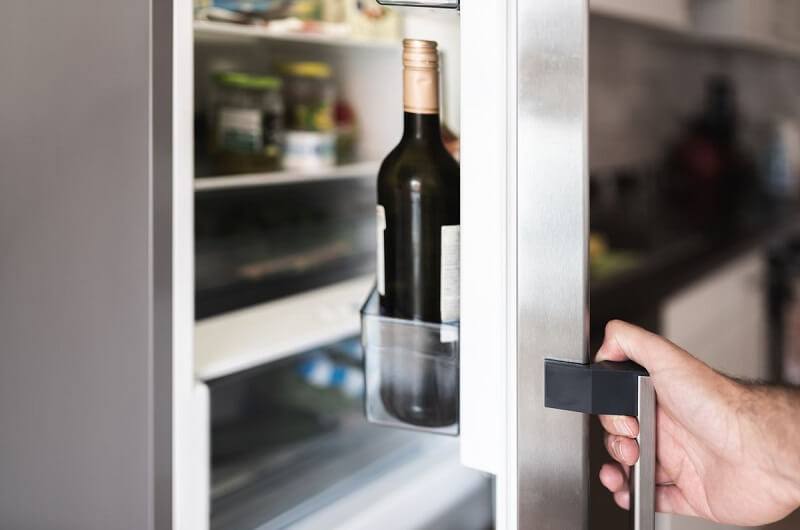Wine, a cherished beverage adored by many, often brings up a myriad of questions when it comes to its storage. You’ve probably found yourself wondering: “Can wine really go bad in the fridge?” Let’s dive deep into this flavorful topic.
The Basics: What Happens to Wine in the Fridge?
Refrigeration slows down the aging process of wine. This can be beneficial for wines that are meant to be enjoyed young, preserving their fresh and fruity characteristics. But, like all good things, there’s a limit.
Temperature Fluctuations
If your fridge often experiences significant temperature changes, this can be detrimental to your wine. The constant expansion and contraction of the wine can push the cork out or allow air to seep in, leading to potential spoilage.
Vibrations and Light
Fridges are notorious for their vibrations from their cooling mechanisms. These vibrations can disturb the sediments in older wines, affecting their taste. Additionally, the constant light inside a fridge can damage wine, especially if it’s in a clear bottle.
Identifying Spoiled Wine: The Tell-Tale Signs
The Appearance
If your wine looks a bit off, that’s your first clue. A brownish hue in your white wine or a brick color in your red wine may indicate oxidation. This isn’t a definitive sign of spoilage but is worth noting.
The Smell
Trust your nose! A wine that’s gone bad often has a sharp, vinegar-like smell. Other off-putting odors to look out for include musty basement, wet cardboard, or even nail polish remover. If your wine smells more like a science project than a delightful beverage, it’s probably past its prime.
The Taste
If you’ve checked the appearance and smell but are still unsure, a small taste can set the record straight. Spoiled wine may taste overly acidic, flat, or just… off. If it doesn’t taste right, it’s best not to drink it.
The Right Way: Tips for Storing Wine in the Fridge
Short-Term Storage
If you’re planning to drink the wine within a few days to a week:
- Keep it upright. This reduces the surface area exposed to oxygen.
- Keep it sealed. If it’s opened, use a wine stopper or vacuum pump to minimize air exposure.
- White wines and rosés are best kept between 44°F to 57°F.
Long-Term Storage
For wines you’re keeping for more than a week:
- Lay it down. This keeps the cork moist and prevents it from drying out.
- Use a wine fridge. These are designed to maintain a consistent temperature and humidity, ideal for wine storage.
- Avoid the door. The temperature near the door fluctuates the most. Keep your wine away from it.
Common Myths About Storing Wine in the Fridge
“All wines improve with age.”
While many wines can benefit from some time in the cellar, not all wines are designed for long-term storage. In fact, most wines available in stores today are best consumed within a few years of purchase. Extended aging, even in optimal conditions, might not do any favors for a young, vibrant wine.
“You should store opened red wine on the counter.”
Once a bottle is opened, oxygen becomes its biggest enemy. Whether it’s red, white, or rosé, storing an opened bottle in the fridge will help slow down the oxidation process. Just remember to let that red come to room temperature before enjoying it again!
“Corked wines can be ‘saved’ by storing them differently.”
A “corked” wine is one that has been tainted by a compound called TCA. Sadly, no amount of refrigeration or storage tricks can reverse this fault. If you believe your wine is corked, it’s best to return it or dispose of it.
Making the Most of Leftover Wine
Cooking with Wine
If you find yourself with wine that’s past its prime for drinking, consider using it for cooking. As a base for sauces or stews, its nuanced flavors can still shine.
Wine Ice Cubes
Pour leftover wine into ice cube trays and freeze. These wine cubes can be a great addition to recipes, sauces, or even drinks that could use a little winey kick.
Wine Vinegar
If your wine has started to turn into vinegar, embrace the transformation! Use it as a base to make homemade wine vinegar. With a mother of vinegar and a little patience, you’ll have a flavorful condiment in no time.
The Science Behind Wine Deterioration
Oxidation
Oxidation is the primary reason wine deteriorates. When wine comes into contact with air, the oxygen reacts with the wine’s compounds, leading to a change in flavor and aroma. Over time, this can transform a fresh and lively wine into a flat and dull drink.
Temperature Extremes
Wine is sensitive to temperature. Extreme cold can cause the wine to freeze, pushing out the cork and potentially breaking the bottle. On the other hand, warm temperatures can speed up the aging process, leading the wine to mature prematurely.
Humidity
Low humidity levels can cause the cork to dry out, allowing air to enter the bottle. Conversely, high humidity can lead to mold growth and label damage, though it’s less harmful to the wine itself.
Final Thoughts: To Fridge or Not to Fridge?
While the fridge is a convenient spot, it’s not always the best place for your beloved bottles. If you’re a casual wine drinker looking to enjoy a bottle within a short time, the fridge will do just fine. But if you’re a collector or have a special bottle you want to age gracefully, consider investing in proper storage solutions like a wine cooler or cellar.
Remember, wine is a living thing. Treat it with care, and it will offer you a symphony of flavors and aromas in return. Cheers to many more delightful sips ahead!
